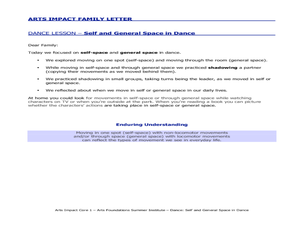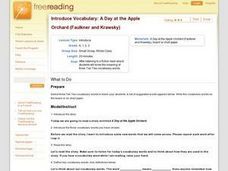Code.org
Cracking the Code
Scholars learn how to crack secret codes as they continue reading from the Blown to Bits and try to crack the random substitution cipher. They also begin learning about the Vigenere cipher.
Curated OER
Self and General Space in Dance
Students explore the different themes and strategies of dancing by performing in class. In this physical education lesson, students practice moving specific joints and muscles as they train to perform a dance. Students perform a dance...
National Council of Teachers of Mathematics
Stitching Quilts into Coordinate Geometry
Who knew quilting would be so mathematical? Introduce linear equations and graphing while working with the lines of pre-designed quilts. Use the parts of the design to calculate the slope of the linear segments. The project comes with...
Curated OER
6-8 Meter Madness
Students identify time signatures, the down beat, and begin to understand conducting patterns. In this meter patterns lesson, students identify the signs for 2/4, 3/4, and 4/4 and play an excerpt from a song. Students use tennis balls to...
Curated OER
"How Do You Measure Up?"
Fourth graders explore basic measurements by analyzing their own bodies. In this human anatomy lesson, 4th graders identify the units used to measure a human body such as centimeters, inches, ounces and pounds. Students complete a...
Curated OER
Cool Line
Students learn foot and arm patterns, then sequence those patterns into a line dance.
Curated OER
Music: Individual and Group Practice
Third graders, in groups and individually, perform various musical pieces on their instruments. After demonstrating how to play steady beats, they also play counter melodies to songs such as "Peace Like a River." While some students...
Curated OER
Introduce Vocabulary: a Day at the Apple Orchard
Students explore language arts by reading a story book in class. In this tier two vocabulary lesson, students read the book A Day at the Apple Orchard and identify the use of specific vocabulary words. Students define the selected vocab...
Curated OER
Here's the Pitch
Students define pitch, measure varying amounts of water into containers, make predictions about the sounds made when striking the containers, put containers in order from highest to lowest pitch, and create their own sound patterns with...
Curated OER
Creating Musical Notation
In this creative music activity from Scientific American, students learn about musical notation and then design their own notations. Great web resource links are alsp provided
Curated OER
And the Verdict Is...
Young scholars identify the unique pattern DNA forms in each individual, and how that pattern can be used to identify criminals. They have the opportunity to simulate the process of matching DNA samples to those taken at a crime scene.
Curated OER
Creating Rose Windows
Learners view a multimedia presentation to recognize rose windows and quilting patterns. In this rose window perimeter lesson, students design rose window from paper. Learners review prior knowledge of lines and how they create shapes.
Curated OER
Brown Bear, Brown Bear
Students complete a variety of activities related to the book "Brown Bear, Brown Bear." They role-play the animals from the story, read about the book's author Bill Martin, Jr. on his website, discuss the rhythm of the story, and create...
Curated OER
Jelly Bean Math
Young scholars estimate, measure, compute, and create patterns using jelly beans. In small groups, they solve various calculations, place jelly beans into groups, invent a new flavor, create a pattern, and complete a worksheet.
Curated OER
Keeping Warm with Fractions
Fourth graders study quilts and related activities to illustrate geometry, basic fractions, and patterning skills. They choose a precut piece of pre-cut color/shape construction paper to discuss the pattern, color, shapes, sizes,...
Curated OER
Magnetism
Second graders conduct a variety of inquiry based learning activities. In this magnetism lesson plan, 2nd graders explore magnets with a partner, they learn the terms attract and repel, examine the poles of a magnet, and complete other...
Curated OER
Theater Game: "The Good, the Bad, and the Bountiful"
Students play a game to demonstrate the detrimental effects of an algal bloom on the environment. In this microorganism lesson, students discuss microbes and algae. They dramatize the effects of an algal bloom using a role-playing game.
Curated OER
Bedroom Floor Plan
Students identify and compare the characteristics of floor plans and zoning to family activities and needs. They draw an accurate floor plan--either existing or a work in progress to scale. Then, students roughly sketch their bedroom...
Curated OER
Powerful Memories, Powerful Words
Students identify and describe the influence slavery had on Mark Twains writing, and then determine the status of race relations and ethnic differences in contemporary life.
Curated OER
Too Bee Or Not To Bee
Students recognize that bees are important in the reproduction of plants and to the survival of animals. In this bee lesson, students become familiar with the parts of bees and how those adaptations help them pollinate plants. Students...
Curated OER
Straw Breathing Exercise
High schoolers fill out an anonymous questionaire to explore whether they might have asthma. They then set up a spreadsheet to enter the data, decide on a definition of asthma, and figure out the prevalence of asthma. Pupils simulate...
Curated OER
Get Ready, Get Set, Get Organized! Lesson 2 of 2
Seventh graders examine the importance of being organized when making transitions. In this organization lesson, 7th graders watch a teacher demonstration of entering a room in a disorganized manner before discussing how the transition...
Curated OER
Strange Sports
Sixth graders compare and contrast strange sports. In this comparing lesson, 6th graders read an article about strange sports then compare and contrast these sports to ones they are familiar with. This lesson includes an assessment,...
Curated OER
Find Someone
Your class will participate in a series of math vocabulary activities to learn about parallel lines. They find people using a math list and connect math words in the context of sentences. They also read the math words in the example...

























